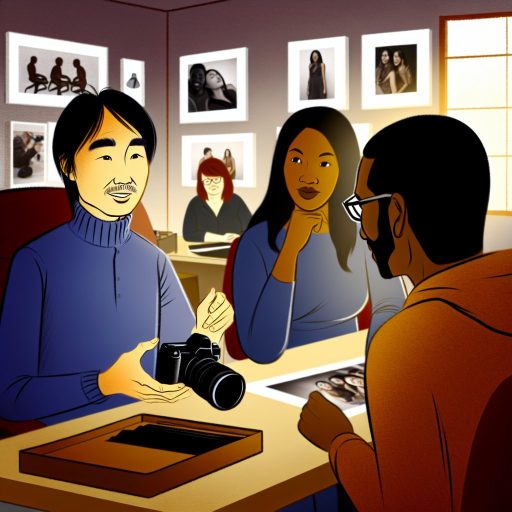Understanding the Importance of a Portfolio in Fashion Design
Defining a Fashion Portfolio
A portfolio showcases a fashion designer’s work and creative vision.
It serves as a visual resume, highlighting skills and achievements.
Designers use portfolios to attract clients and employers.
A well-organized portfolio helps communicate unique design capabilities.
Significance in Job Applications
Employers often base hiring decisions on portfolio quality.
A strong portfolio can set you apart in a competitive market.
It displays your understanding of current fashion trends.
Furthermore, it illustrates your ability to create original designs.
Building a Personal Brand
Your portfolio contributes to your personal brand identity.
It reflects your style, aesthetic, and professional philosophy.
A distinctive portfolio helps you get recognized in the industry.
This recognition can lead to more job opportunities.
Adapting to Industry Standards
Fashion portfolios must align with industry expectations and trends.
By staying updated, you can keep your portfolio relevant.
Critical elements include high-quality photographs and compelling narratives.
Incorporating feedback from industry peers can enhance your work.
Showcasing Versatility
A diverse portfolio can demonstrate your range as a designer.
It should include various styles, types of garments, and techniques.
Having different projects reflects your adaptability to client needs.
This versatility can attract a broader audience for your work.
Choosing the Right Format: Digital vs. Physical Portfolios
Understanding Digital Portfolios
Digital portfolios are becoming increasingly popular among fashion designers.
They allow for easy sharing and accessibility worldwide.
Designers can create interactive presentations using various software.
Moreover, digital portfolios can incorporate video and animations.
This medium offers more flexibility in showcasing skills and creativity.
Unlock Your Career Potential
Visualize a clear path to success with our tailored Career Consulting service. Personalized insights in just 1-3 days.
Get StartedBenefits of Digital Portfolios
One major advantage is the ease of updating content.
Designers can swiftly add new projects and remove outdated work.
Additionally, digital portfolios can reach a wider audience.
Many potential employers prefer receiving applications online.
Overall, a digital presence enhances discoverability.
Understanding Physical Portfolios
Physical portfolios also hold significant value in the fashion industry.
They create a tangible experience for clients and interviewers.
Having a well-crafted physical portfolio demonstrates professionalism.
It allows designers to showcase textures and materials firsthand.
Additionally, the tactile experience can impress potential employers.
Benefits of Physical Portfolios
Physical portfolios stand out during in-person interviews.
They provide an opportunity for personal interaction with designs.
Furthermore, they can highlight craftsmanship in a unique way.
Designers can control the presentation environment effectively.
Overall, a physical portfolio can make a lasting impression.
Combining Digital and Physical Portfolios
Many successful designers utilize both digital and physical formats.
This hybrid approach capitalizes on the strengths of each medium.
For instance, they can use digital platforms for broad outreach.
Simultaneously, they can bring physical versions to interviews.
The combination showcases adaptability and readiness for any situation.
Incorporating a Variety of Works
Key Types of Projects to Showcase
A diverse portfolio highlights your versatility as a fashion designer.
Begin by including sketches that demonstrate your creative thought process.
Sketches provide insight into your design ideas and concepts.
Next, feature finished garments that showcase your technical skills.
Garments can illustrate your understanding of fabric, fit, and construction.
Include photography of your work in styled shoots or lookbooks.
Styled shoots help potential employers visualize your designs in real-world settings.
Consider adding collaborations with other designers or artists.
Collaborative projects can expand your creative reach and profile.
Forming partnerships brings new perspectives and ideas to your work.
Furthermore, highlight any fashion shows or exhibitions where you’ve participated.
These events demonstrate your commitment and exposure in the industry.
Client work, if applicable, should be included as well.
Client projects showcase your ability to work to specific briefs and requirements.
Be sure to present a cohesive narrative throughout your portfolio.
A cohesive story will engage viewers and leave a lasting impression.
Finally, keep your portfolio updated with your best and most recent work.
Regular updates ensure that your portfolio reflects your current skills and style.
Discover More: How to Price Your Fashion Designs for Profit and Value
Highlighting Your Personal Style and Design Aesthetic
Defining Your Unique Identity
Your fashion portfolio conveys your personal identity.
Choose pieces that reflect your design philosophy.
Highlight your favorite materials and techniques.
This establishes a signature style that’s recognizable.
Exploring Diverse Influences
Incorporate influences from various cultures and eras.
Research iconic designers to inspire your creativity.
Utilize elements from nature in your designs.
This diversity enriches your design aesthetic.
Showcasing Your Work
Present your strongest pieces first in your portfolio.
Use high-quality images to capture intricate details.
Write accompanying descriptions to explain your vision.
Include sketches to highlight your design process.
Maintaining Consistency
Ensure a cohesive look throughout your portfolio.
Choose a consistent color palette and typography.
This unifies your work and reinforces your brand.
Updating Regularly
Keep your portfolio current with your latest projects.
Remove older work that no longer represents you.
This keeps your portfolio fresh and engaging.
Explore Further: How to Monetize Your Skills as a Canadian Content Creator
Crafting Compelling Narratives: Describing Your Design Process
The Importance of Storytelling
Storytelling is an essential element in fashion design.
It connects your audience to your vision and creative journey.
A compelling narrative adds depth to your portfolio.
Every piece you create has a unique story behind it.
Engaging stories captivate potential employers and clients.
Identifying Your Inspiration
Begin by pinpointing what inspires your designs.
Inspiration can come from various sources.
Art, culture, nature, and personal experiences are all valid influences.
Clearly articulate your sources of inspiration in your work.
This helps others understand your creative perspective.
Detailing Your Design Process
Next, describe your design process step-by-step.
Start with brainstorming ideas and concepts.
Include sketches and mood boards to visualize your thoughts.
Document how you develop these ideas into tangible designs.
Consider including photographs or illustrations of your work.
Highlighting Challenges and Solutions
Discuss any challenges you faced throughout the design process.
Identify specific obstacles that required creative problem-solving.
Explain how you overcame these challenges effectively.
This demonstrates resilience and adaptability in your work.
Incorporating Feedback and Revisions
Add a section about the importance of feedback.
Share how peer or mentor critiques influenced your designs.
Detail how revisions led to stronger final products.
Highlighting collaboration shows your openness to growth.
Reflecting on Your Journey
Finally, reflect on your design journey and growth.
Consider how your style has evolved over time.
Share your aspirations for future projects and goals.
This personal touch makes your portfolio memorable.
Overall, a compelling narrative enhances your design portfolio significantly.
Learn More: The Role of Technology in Modern Fashion Design

Optimizing Visual Presentation: Tips for Photography and Layout
Importance of Quality Photography
Quality photography makes a significant impact on your portfolio.
It showcases your designs effectively to potential employers or clients.
Invest in a good camera or hire a professional photographer.
Natural lighting enhances the details in your garments.
Avoid using harsh flash, as it can distort colors.
Styling Your Fashion Pieces
Ensure your clothing items are well-styled before shooting.
Use accessories to complement the outfits.
Consider using a model to bring your designs to life.
Choose a setting that reflects the mood of your design.
A clean background helps your garments stand out.
Editing Your Photographs
Post-processing enhances your photos significantly.
Use editing software to adjust brightness and contrast.
Remove any distracting elements from the background.
Ensure colors are true to life to avoid misrepresentation.
Effective Layout Design
A cohesive layout presents your work professionally.
Organize images and text to guide the viewer’s eye.
Use a consistent color palette for a unified look.
Incorporate white space to create balance and clarity.
Utilizing Online Platforms
Design a digital portfolio to reach a broader audience.
Select platforms that best showcase your work.
Ensure your website is mobile-friendly and easy to navigate.
Integrate links to your social media for further engagement.
Gathering Feedback
Seek constructive feedback on your presentation.
Join fashion design communities for critique and advice.
Regularly update your portfolio based on this feedback.
This ensures your portfolio evolves with your developing style.
Explore Further: Exploring Lucrative Niches in the Photography Industry
Maintaining and Updating Your Portfolio Regularly
Establish a Routine
Developing a routine for portfolio updates is essential.
Schedule regular intervals, like quarterly or bi-annually.
This practice keeps your portfolio fresh and relevant.
Consider setting reminders to ensure you stay on track.
Review Content Periodically
Regularly review the content of your portfolio.
Evaluate which pieces represent your best work.
Remove outdated or less impressive projects to enhance quality.
Consider feedback from peers or mentors during this process.
Add New Work
Incorporate new projects as you complete them.
This showcases your growth and evolving style.
Highlight diversity in your work to attract various clients.
Include sketches, final designs, and photoshoots for completeness.
Optimize for Presentation
Ensure that your portfolio is visually appealing.
Maintain a consistent layout and design throughout.
Use high-quality images that effectively showcase your work.
Consider digital formats for easy accessibility.
Seek Constructive Feedback
Engage with industry professionals for feedback on your portfolio.
Attend fashion events or workshops for insight into industry standards.
This interaction can inspire new ideas for your portfolio.
Use feedback to make meaningful improvements.
Adapt to Trends
Stay updated on the latest fashion industry trends.
Reflect current styles and techniques in your portfolio.
Adapting shows your relevance and awareness of the industry.
Research competitors to identify successful traits in their portfolios.
Leveraging Social Media and Online Platforms for Portfolio Exposure
Choosing the Right Platforms
Start by identifying the social media platforms that best suit your style.
Consider Instagram for visual appeal and audience engagement.
Furthermore, use Pinterest to showcase your design concepts and trends.
LinkedIn serves well for professional networking and connections.
Creating Engaging Content
Focus on high-quality images of your designs and projects.
Include behind-the-scenes videos of your creative process.
Moreover, share stories that resonate with your audience.
Utilize engaging captions to draw viewers in.
Building a Consistent Brand Image
Establish a cohesive aesthetic across all platforms.
This reinforces your brand identity and makes you memorable.
Update your portfolio consistently to keep your audience informed.
Stay true to your design philosophy in every post.
Engaging with Your Audience
Regularly respond to comments and direct messages.
This fosters a sense of community around your brand.
Host Q&A sessions or live chats to engage followers directly.
Collaborating with Influencers
Identify influencers who align with your brand values.
Collaboration can help you reach a wider audience.
Consider co-creating content that showcases both of your styles.
Utilizing Hashtags and SEO
Research trending hashtags within the fashion industry.
Incorporate these hashtags in your posts for better visibility.
Additionally, optimize your profile for search engines.
Use keywords that reflect your design style and expertise.
Tracking and Analyzing Performance
Regularly review your engagement metrics across each platform.
This data helps you understand what content resonates most.
Adjust your strategy based on this performance analysis.
Continuously refine your approach to maximize exposure.
Additional Resources
After I get a bachelor’s degree in fashion design, should I get a job or …
Is game development as a career a mistake? What’s it REALLY like …




